Get the Confident Smile You Deserve with Braces in New Jersey
Braces

Our practice also recognizes that adults and children have different needs, and require a different level of attention and care. We will work with you to ensure that you receive the most appropriate treatments, and that your needs are met with understanding, respect, and full commitment from us.
For Children
While there is no exact age for children to begin orthodontic treatment, the American Association of Orthodontists recommends visiting the orthodontist around age seven. Early treatment allows your orthodontist to correct and guide your child’s jaw, create more space for crowded teeth, avoid the need for extractions later in life, and correct thumb sucking and minor speech problems.

There are a few things to watch for that may mean your child needs to see an orthodontist, such as crowded or misplaced teeth, difficulty chewing or biting, mouth breathing, thumb sucking, or popping jaws.
For Teens
Braces are no longer as scary as many teens may think. In fact, braces today come in a variety of styles, materials, and colors, making life with braces much easier, more comfortable, and even more stylish than in the past. There are several treatment options to choose from, including traditional metal, ceramic, and invisible braces. Treatment times can vary depending on how quickly your body responds and how much work is needed to give you the show-stopping smile you expect. Regardless of the type of braces you choose, it is important to avoid sticky, hard, or chewy foods, as these may damage your braces and prolong your treatment time.
For Adults
Orthodontic treatment is no longer just for teens! In fact, according to the American Association of Orthodontists, one in five orthodontic patients is over the age of 21! Many adults are choosing to receive treatment because they understand the importance of maintaining their health and they want to feel better about their appearance. Today’s orthodontic treatment options offer a variety of braces and appliances that are comfortable, aesthetic, and customized to meet your needs, such as clear braces, self-ligating braces, lingual braces, and clear aligners. Remember, a straight smile isn’t just beautiful; it will help you maintain the health of your teeth for life!
Types of Braces
Traditional Metal Braces
Traditional metal braces are the most common type of braces and are more comfortable today than ever before. Made of high-grade stainless steel, metal braces straighten your teeth using metal brackets and archwires. With metal braces, you have the option of adding colored elastics (rubber bands) for a more unique and colorful smile.
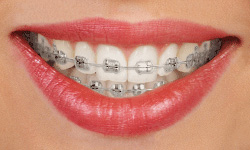
Self-Ligating Braces
Self-ligating braces are made from the same materials as traditional braces. However, self-ligating braces do not require the use of elastics, meaning fewer appointments and less friction being placed on the tooth. Self-ligating braces come with traditional metal, ceramic, or clear brackets. They are the same size as metal braces, but use a specialized clip in place of elastics to help the arch wire guide teeth into place. The clip helps reduce the amount of pressure being placed on the tooth, and requires fewer adjustments because there are no elastics to replace.
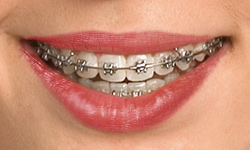
Clear (Ceramic) Braces
Ceramic braces are made of clear materials and are therefore less visible on your teeth than metal braces. For this reason, ceramic braces are used mainly on older teenagers and adult patients who have cosmetic concerns. While they are visually less prominent, they do require more attention to oral hygiene as ceramic braces are larger and are more brittle than their metal counterparts. For these reasons, ceramic braces tend to be used more on upper front teeth than on lower teeth.
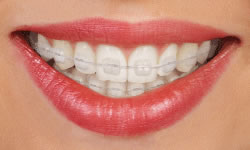
Clear Aligners
Clear aligners are a series of invisible, removable, and comfortable acrylic trays that straighten your teeth like braces. Not only are the aligners invisible, they are removable, so you can eat and drink what you want while in treatment, plus brushing and flossing are less of a hassle. The aligners are comfortable and have no metal to cause mouth abrasions during treatment.

Brushing Instructions
When you have braces it’s very important to brush and floss after every meal in order to keep your teeth and gums healthy throughout your treatment. If you need help choosing the right toothbrush, toothpaste, and dental floss, please ask us and we can help you choose the right products for your teeth and your appliance.
You’ll also need to be careful about what you eat to prevent breaking your braces or bending the wires.
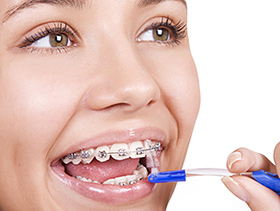
Brushing Instructions
 Brushing: Step 1
Brushing: Step 1
Place your toothbrush at a 45 degree angle to your gum.
 Brushing: Step 2
Brushing: Step 2
Brush gently in a circular motion.
 Brushing: Step 3
Brushing: Step 3
Brush the outer, inner, and chewing surfaces of each tooth.
 Brushing: Step 4
Brushing: Step 4
Use the tip of your brush for the inner surface of your front teeth.
Flossing Instructions
 Flossing: Step 1
Flossing: Step 1
Wind about 18 inches of floss around your fingers as shown. Most of it should be wrapped around one finger, and as the floss is used, the other finger takes it up.
 Flossing: Step 2
Flossing: Step 2
Use your thumbs and forefingers to guide about one inch of floss between your teeth.
 Flossing: Step 3
Flossing: Step 3
Holding the floss tightly, gently saw the floss between your teeth. Then curve the floss into a C-shape against one tooth and gently slide it beneath your gums.
 Flossing: Step 4
Flossing: Step 4
Slide the floss up and down, repeating for each tooth.
Eating with Braces
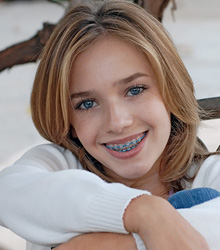
Foods to avoid with braces:
- Chewy foods — bagels, licorice
- Crunchy foods — popcorn, chips, ice
- Sticky foods — caramel candies, chewing gum
- Hard foods — nuts, hard candies
- Foods that require biting into — corn on the cob, apples, carrots
Foods you CAN eat with braces:
- Dairy — soft cheese, pudding, milk-based drinks
- Breads — soft tortillas, pancakes, muffins w/o nuts
- Grains — pasta, soft cooked rice
- Meats/poultry — soft cooked chicken, meatballs, lunch meats
- Seafood — tuna, salmon, crab cakes
- Vegetables — mashed potatoes, steamed spinach, beans
- Fruits — applesauce, bananas, fruit juice
- Treats — ice cream w/o nuts, milkshakes, Jell-O, soft cake
Soreness caused from braces and appliances
When you first get your braces, you may notice that your teeth and mouth feel a little tender or sore. This is perfectly normal for patients who have just gotten their braces put on, and we promise your mouth will not be sore forever! To relieve the pain, we recommend dissolving one teaspoon of salt in eight ounces of lukewarm water. Swish and gargle this solution in your mouth for just a couple of minutes (do not swallow the saltwater).
If the pain is more severe and does not go away after rinsing, you can also try taking a pain reliever. It is also not uncommon for your lips, cheeks, and tongue to become irritated for one to two weeks as they toughen and become used to the braces. We would be happy to give you some wax that you can put over the braces to lessen the tenderness. If you need some wax, please let us know!
Loose Teeth
If your teeth begin feeling a little loose, don’t worry; this is normal! Your braces must first loosen your teeth in order to move them into the right position. Once your teeth have been repositioned, they will no longer be loose.
Loose Wires and Bands
The wires and bands on your braces may come loose. If this happens, please contact us as soon as possible so that we can check and repair your appliance. If any piece of your appliance comes off, be sure to save it and bring it to the office with you.
You can temporarily fix the loose wire by using the back of a spoon or the eraser end of a pencil to carefully and gently push the wire back into place. If the loose wire is causing irritation to your lips or cheeks, put wax or a wet cotton ball over the broken wire to relieve the pain.
Take Care of your Appliances
Damaged appliances can increase the length of your treatment process, so be sure to take care of all your appliances. Your teeth and jaw can only move into their correct positions if you consistently wear the rubber bands, headgear, retainer, or other appliances prescribed by your doctor.
Playing Sports with Braces
Game, Set, Match — we have great news for athletes! You can still play sports even while undergoing orthodontic treatment! If you do play sports, it’s recommended that you wear a mouthguard in order to protect your teeth and your appliance. Let your doctor know if you need help finding the right mouthguard for the best protection.
In case of a sports emergency, be sure to immediately check your mouth and your appliance for any damage that may have occurred. If you notice any loose teeth, or if your appliance has been damaged, please contact our office right away. You can temporarily relieve the discomfort with wax or by rinsing your mouth with warm saltwater.
Mouthguards Protect Your Teeth and Braces
Sports related injuries to the mouth and jaw are some of the most common injuries received by athletes. Protecting your smile while playing sports is essential when you have braces. Mouthguards help protect your teeth and gums from injury. If you participate in high-contact sports the American Association of Orthodontists recommends you wear a mouthguard. Be sure to ask your doctor about mouthguards at your next appointment.

 Brushing: Step 1
Brushing: Step 1 Brushing: Step 2
Brushing: Step 2 Brushing: Step 3
Brushing: Step 3 Brushing: Step 4
Brushing: Step 4 Flossing: Step 1
Flossing: Step 1 Flossing: Step 2
Flossing: Step 2 Flossing: Step 3
Flossing: Step 3 Flossing: Step 4
Flossing: Step 4